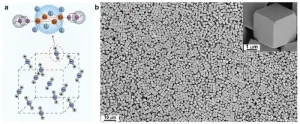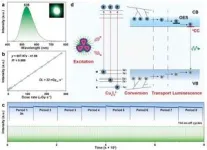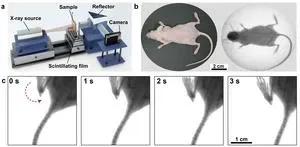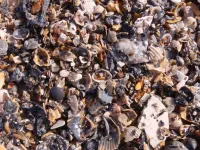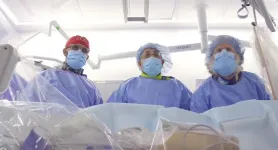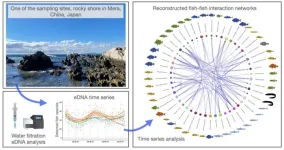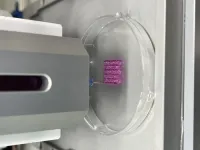Efficient X-ray luminescence imaging with ultrastable and eco-friendly copper(I)-iodide cluster microcubes
2023-07-11
(Press-News.org)
Scintillators are optical materials that emit low-energy ultraviolet and visible photons in response to ionizing radiation such as X-rays and gamma rays. This property makes scintillating materials useful for applications like non-destructive testing, X-ray astronomy, security inspection, and medical imaging.
In a recently published paper in Light Science & Applications, Professor Xiaowang Liu and Academician Wei Huang, along with their team from the Institute of Flexible Electronics at Northwestern Polytechnical University, introduced a novel class of X-ray scintillator based on monodisperse copper-iodine clusters. The synthesized microcubes demonstrated remarkable sensitivity to X-rays and exhibited excellent stability when exposed to humidity and X-ray irradiation. The uniform size distribution and superior scintillation performance of the copper-iodide cluster-based microcubes make them highly suitable for the production of large-area flexible scintillation films used in both static and dynamic X-ray imaging applications.
Traditional inorganic scintillators containing heavy metals offer excellent performance but face limitations in large-area and flexible X-ray detector development due to their high-temperature bulk crystal growth requirement. Moreover, commercially available scintillators like CsI:Tl and LaBr3:Ce are hygroscopic, adding complexity to device fabrication. Recent advancements in metal halide nanocrystals hold promise as a new class of solution-processable scintillators with improved performance. However, the challenge lies in developing efficient nano- and micro-scintillators with uniform morphology, environmentally-friendly composition, robust chemical stability, and integration into stretchable substrates for flexible X-ray detectors.
Copper-iodine cluster crystals, comprising inorganic cores and organic ligands, show the potential to be a new class of high-performance scintillators to address the challenges mentioned above due to the fact that: (i) These materials possess large effective atomic numbers, enabling strong X-ray blocking ability; (ii) The photoluminescence and semiconducting properties contribute to excellent X-ray conversion efficiency; (iii) Structural engineering enhances the lattice stability of Cu-I cluster scintillators, making them more resistant to moisture and facilitating rational crystal growth through wet-chemical processes.
In this report, the authors introduce the advancement of high-performance monodisperse microcube scintillators composed of copper iodide-(1-propyl-1,4-diazabicyclo[2.2.2]octan-1-ium)2 (Cu4I6(pr-ted)2). The crystal structure of Cu4I6(pr-ted)2 is presented in Fig. 1a. Through the utilization of the hot-injection method, microcubes with a uniform size distribution were successfully synthesized (Fig. 1b).
The optical characterization of the prepared microcubes revealed a luminescence peak at 535 nm, accompanied by a relatively low photoluminescence quantum yield (PLQY) of 40.6%. However, this limitation can be effectively addressed by subjecting the microcubes to annealing in a N2 atmosphere, thereby enhancing their crystallinity. Remarkably, following the annealing process, the PLQY experiences a substantial improvement, reaching an impressive value of 97.1%. Apart from the enhanced PLQY, the microcubes exhibit exceptional water resistance, surpassing that of both traditional scintillators and perovskite scintillators. Notably, when immersed in an aqueous solution, the luminescence intensity of the microcubes remains stable for an impressive duration of 18 h. This remarkable stability further reinforces the suitability of these microcubes for practical applications.
The radioluminescence characterization reavealed a emission peak aligning with the photoluminescence observed in Cu4I6(pr-ted)2 microcubes and showcases an exceptionally low X-ray detection limit (DL) of 22 nGyair s-1, along with outstanding radiation stability (Fig. 2a-c). The proposed scintillation mechanism is illustrated in Fig. 2d. Upon exposure to X-rays, the heavy elements like Cu and I, effectively absorbs high-energy photons, resulting in the generation of numerous energetic primary electrons. These primary electrons, in turn, give rise to secondary electrons through a combination of processes such as photoelectric absorption, Compton scattering, and pair formation. As high-energy secondary electrons move within the host lattice, they lose energy through interactions with the lattice and other electrons, producing many excitons. These excitons are then transformed into low-energy scintillation photons through radiative recombination in the 3CC states of optical exciton states.
The prepared Cu4I6(pr-ted)2 microcubes exhibit excellent scintillation performance, showcasing their immense potential in the realm of X-ray imaging. To further explore their practical applications, the microcubes were doped into polydimethylsiloxane (PDMS) as energy conversion fillers, resulting in the fabrication of a flexible X-ray scintillator screen. Leveraging this film, an X-ray imaging system was successfully constructed, enabling static and dynamic X-ray imaging of a mouse (Fig. 3). This achievement underscores the versatility and adaptability of Cu4I6(pr-ted)2 microcubes as a promising material for real-world applications in the field of X-ray imaging. Their incorporation into flexible scintillator films allows for the development of innovative and efficient imaging systems, opening doors to various biomedical and industrial applications.
END
ELSE PRESS RELEASES FROM THIS DATE:
2023-07-11
DALLAS, July 11, 2023 — Two dedicated volunteers have reached a prestigious milestone with the American Heart Association, the world’s leading nonprofit organization devoted to a world of healthier lives for all, for their personal passion and commitment to advance women’s heart health.
For the third year, changemakers across the country were nominated to join the American Heart Association’s Woman of Impact and Teen of Impact® campaigns. Aligning with the Go Red for Women® movement, the Association’s signature ...
2023-07-11
The Xerces Blue butterfly (Glaucopsyche xerces) was native to the coastal dunes of San Francisco, in the United States. As the city grew, much of the butterfly’s habitat was destroyed and its population was relegated to Golden Gate National Park. Its wings were a deep iridescent blue, with characteristic white spots on the ventral side. The last surviving specimens of the species were found in 1941, by entomologist W. Harry Lange. It is considered the first insect species to have become extinct in historical times. Its disappearance has made it a global icon of anthropogenic extinction, to ...
2023-07-11
Washington, D.C. – Bacteria found in 74 kitchens spread among 5 European countries were mostly harmless according to new research published in Applied and Environmental Microbiology, a journal of the American Society for Microbiology.
“We have previously found considerable variations in kitchen standards, food preparation practices, and cleaning regimes between France, Norway, Portugal, Romania, and Hungary,” said Birgitte Moen, Ph.D., Scientist—Department of Food Safety and Quality, Nofima—Norwegian Institute of Food, Fisheries, and Aquaculture Research, Ås, Norway.
In ...
2023-07-11
The aim is to maximize impact by turning to the combined talent and insight of the broader international neuroscience community.
SEATTLE — July 11, 2023 — Today, scientists from the Allen Institute for Neural Dynamics, a division of the Allen Institute, launched the world’s first completely open- and crowd-sourced neuroscience experiment—inviting researchers from around the world to publicly design a shared experiment that will run on the Allen Brain Observatory, as part of the Institute’s OpenScope program. Experiments will probe ...
2023-07-11
Biologists attempting to conserve and restore denuded environments are limited by their scant knowledge of what those environments looked like before the arrival of humans. This is especially true of coastal ecosystems, many of which had already been drastically altered by pollution and overharvesting hundreds of years before scientists began monitoring them.
According to a new study published in the journal PeerJ, a faithful analogue of modern marine ecosystems lies just beneath the surface. Building on more than 20 years of conservation paleobiology, the results suggest that fossils of various marine groups — including worms, mollusks, crabs and sea urchins — are ...
2023-07-11
Click here to watch a video on the new Cath Lab
Mount Sinai Queens today announced the opening of a new cardiac catheterization lab that will provide rapid and comprehensive care to hundreds of heart patients every year for life-threatening emergencies and scheduled cardiac procedures. The first cardiac catheterization lab in Astoria, it will transform treatment for patients in the growing communities of western Queens by vastly improving access to cardiac care in the borough and beyond.
Atul Kukar, DO, has been named the Director of the Mount Sinai Queens Catheterization Lab and leads a team of 14 specialists including interventional cardiologists, nurses, and technicians.
“Our ...
2023-07-11
There is a “silent hazard” lurking underneath our major global cities, and our buildings were not designed to handle it.
A new Northwestern University study has, for the first time, linked underground climate change to the shifting ground beneath urban areas. As the ground heats up, it also deforms. This phenomenon causes building foundations and the surrounding ground to move excessively (due to expansions and contractions) and even crack, which ultimately affects structures’ long-term operational performance and durability. Researchers also report that past building damage ...
2023-07-11
A team led by the Hong Kong University of Science and Technology (HKUST) has developed a technique to study how different fish species interact with each other in a coastal region, a breakthrough that helps explain the complex relationships among marine species and how global warming impacts fish populations.
By analyzing minute traces of fish DNA from samples of seawater, the team combined the use of environmental DNA – known as eDNA – and advanced statistical analysis to not only detect ...
2023-07-11
Motor learning skills let us move through the world: we use them to teach ourselves how to walk, how to pick up a drink, how to run. But age or sickness can weaken our ability to learn motor tasks. Scientists studying the impact of oxygen supplementation on motor learning have found a promising treatment that could help patients who have experienced neurological trauma recover old skills.
“A simple and easy to administer treatment with 100% oxygen can drastically improve human motor learning processes,” said Dr Marc Dalecki, now at the German University of Health and Sports in Berlin, senior author of the study in Frontiers in Neuroscience.
Repurposing ...
2023-07-11
A three-dimensional (3D) bioprinting technology capable of eliminating cancer cells using the function of immune cells has been developed for the first time in the world.
Through joint research with the Korea Institute of Machinery and Materials (President Sang Jin Park, hereinafter referred to as KIMM), the Korea Research Institute of Bioscience and Biotechnology (President Jang Seong Kim, hereinafter referred to as KRIBB), institute under the jurisdiction of the Ministry of Science and ICT, developed a 3D bioprinting technology using natural killer cells (NK cells)* as a new method of immunotherapy for treating cancer, and ...
LAST 30 PRESS RELEASES:
[Press-News.org] Efficient X-ray luminescence imaging with ultrastable and eco-friendly copper(I)-iodide cluster microcubes
